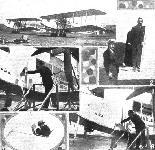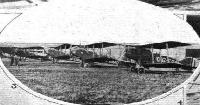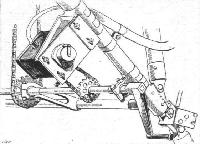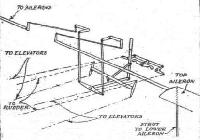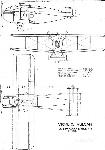Фотографии
-
THE FLIGHT AROUND THE WORLD: On the left is seen the fuselage of the D.H.9 on which the aviators are to attempt the flight from London to Calcutta. The photograph was taken at the Aircraft Disposal Co.'s works at Waddon on Thursday of last week, indicating that no time was lost in getting the machine ready in time. On the right is a snapshot of Capt, Macmillan and Maj. W. Blake, taken at Croydon.
Самолёты на фотографии: De Havilland D.H.9 - Великобритания - 1917
-
THE AIRCRAFT DISPOSAL CO., WADDON: 1, Shows two D.H.9 fuselages on the floor of their packing case, the sides of which may be seen lying down ready to be put in place. 2, A D.H.9 landing after going through its acceptance flight. 3, A Bristol Fighter and three D.H.9's ready for tests. 4, A packing case containing two D.H.9 fuselages being hoisted on to the lorry which Is to take them to the docks for shipment.
Самолёты на фотографии: De Havilland D.H.9 - Великобритания - 1917
-
RUSSO-GERMAN AIR MAIL SERVICE: Our photograph shows two of the Fokker monoplanes to be used on the Konigsberg-Moscow service, which was inaugurated on May 1. At first the service will be bi-weekly, the machines leaving Konigsberg at 9 a.m., arriving at Smolensk at 4.15 p.m., leaving Smolensk at 4.45 p.m., and arriving at Moscow 7.45 p.m. In the opposite direction the times are as follows: Moscow 6.30 a.m., Smolensk 9.30, leave Smolensk 10, arrive Konigsberg 3.15 p.m. Machines will leave Konigsberg on Sundays and Thursdays, and Moscow Sundays and Wednesdays. The railway journey between Berlin and Konigsberg occupies 12 1/2 hours, and the flight between Konigsberg and Moscow 9 hours, giving a total of 22 hours, as compared with more than five days by train. The air mail fees are to be 8 marks for post cards and 8 marks for every 20 grammes in the case of letters.
Самолёты на фотографии: Fokker F.III - Нидерланды - 1921
-
Inauguration of London-Brussels Air Service: On Monday of last week the Instone Air Line inaugurated their service between London and Brussels by sending one of the new Napier-engined D.H.34 biplanes to Brussels and back, piloted by Capt. Barnard. The occasion was recorded in last week's issue of FLIGHT. Our photograph shows the machine just before the start, Capt. the Hon. F. E. Guest being seen in conversation with Sir Samuel Instone, while, in the foreground, with his back to the camera, is Sir Frederick Sykes, late Controller-General of Civil Aviation.
Самолёты на фотографии: De Havilland D.H.32 / D.H.34 - Великобритания - 1921
-
Регистрационный номер: G-EBBG, G-EBBH "LAUNCHING" TWO HANDLEY PAGE W.8B BIPLANES: On May 16 two of the new W.8B's to be put on Vhe London-Paris air service were christened by Major-General Sir Sefton Brancker, the new Director of Civil Aviation. The names of the two machines are "Princess Mary" and "Prince George." Our Photographs show - 1 The two machines before the christening. 2. Mr. Handley Page and, in the doorway of the machine, the D. of C.A. 3. Sir Sefton Brancker breaks a bottle of champagne on the first machine and (4) tears off the strip which covers the name. In 5 Lieut.-Col. Barrett-Lennard is seen explaining some of the details to Sir Sefton Brancker.
Самолёты на фотографии: Handley Page H.P.18 (W.8) / H.P.30 (W.10) - Великобритания - 1919
-
THE AIRCRAFT DISPOSAL CO., WADDON: A Bristol Fighter and three D.H.9's ready for tests.
Самолёты на фотографии: Bristol F.2A/F.2B Fighter - Великобритания - 1916
-
AERIAL "OBLIQUE" PHOTOGRAPHS, ILLUSTRATING FOREST RECONNAISSANCE, TIMBER CRUISING AND FIRE PROTECTION AS CARRIED OUT BY SEAPLANE IN CANADA: 1. Distant view of forest and lake area; altitude 3,000 ft. Note point of land x. 2. Nearer view of point of land shown at x in 1; altitude 1,000 ft. 3. "Close-up" view of same area, showing actual timber types; altitude 200 ft. 4. A flying boat on patrol, as seen from another machine flying above it. 5. Landing supplies for fire fighters on a lake near the scene of the fire. 6. Comparison of the old and the new way. The former is illustrated in the photograph by the look-out tower at Norway House, Lake Winnipeg, photographed from the seaplane which provides the new way.
Самолёты на фотографии: Curtiss HS - США - 1917
-
Регистрационный номер: G-EBBL [2] THE VICKERS "VULCAN," 360 H.P. ROLLS-ROYCE "EAGLE" ENGINE. - This machine was described and illustrated in detail in our issue of May 4, 1922, but photographs have not been available until now. The machine carries eight passengers in a roomy cabin, and will shortly be put on the London-Brussels service by the Instone Air Line.
Самолёты на фотографии: Vickers Vulcan / Type 61 - Великобритания - 1922
-
Регистрационный номер: G-EBBL [2] THE VICKERS "VULCAN" COMMERCIAL MACHINE: Three-quarter rear view. A feature of this machine is the exceptionally low landing speed of 40 m.p.h., and the quick pull-up after touching. The "Vulcan" also gets off after a very short run, and climbs steeply. The power expenditure is only 45 h.p. per passenger carried, so that the machine should be very economical.
The first Vulcan in Instone Air Line livery as City of Antwerp. The additional fins have not yet been fitted.Самолёты на фотографии: Vickers Vulcan / Type 61 - Великобритания - 1922
-
The Vickers "Vulcan": Three-quarter front view of fuselage before engine cowl and fabric covering of rear portion are put on.
Самолёты на фотографии: Vickers Vulcan / Type 61 - Великобритания - 1922
-
THE VICKERS "VULCAN": Some details of the construction of circular and streamline section struts and longerons.
Самолёты на фотографии: Vickers Vulcan / Type 61 - Великобритания - 1922
-
THE VICKERS "VULCAN": Details of the starting gear, showing starting magneto, adjustable eccentric bushes, etc.
Самолёты на фотографии: Vickers Vulcan / Type 61 - Великобритания - 1922
-
THE VICKERS "VULCAN": Some constructional details. 1. Lattice rib construction. 2. Balanced aileron. 3. Details of aileron mounting. 4. The fairing behind the pilot's head has a tubular stiffening piece to act as a protection in case the machine turns over. Inside the fairing may be seen the ventilator for the cabin. 5. shows details of the manner of building a light structure on to the main fuselage girder in order to turn it into an elliptical section. 6. One of the fuselage longeron clips. (Note the aluminium packing piece which allows of tightening up the fitting in case of shrinkage of the longeron.) 7. One of the petrol tanks mounted on the top plane. 8 is an underneath view of the sump of the petrol tank. 9 shows the detachable steel shoe on the tail skid. 10 and 11 are views of one of the seats, open and folded. 12. Shows the details of the undercarriage where the struts meet the axle. Note how the bending moment has been kept as small as possible by fitting the struts close to the inner end of the wheel hub.
Самолёты на фотографии: Vickers Vulcan / Type 61 - Великобритания - 1922
-
THE VICKERS "VULCAN": Perspective diagram of the control system.
Самолёты на фотографии: Vickers Vulcan / Type 61 - Великобритания - 1922
-
Vickers Vulcan 375 hp Rolls Eagle VIII Engine
Самолёты на фотографии: Vickers Vulcan / Type 61 - Великобритания - 1922
Статьи
- Flight




